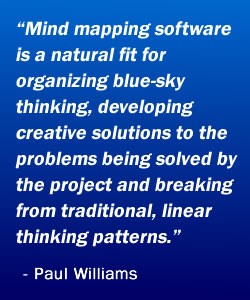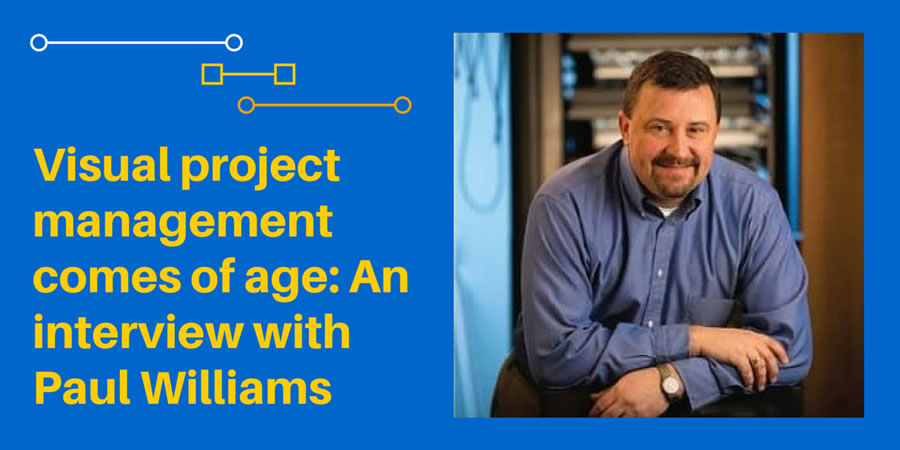In recent years, visual project management has emerged as a set of tools and techniques that help project managers to make sense of and manage large, complex projects more effectively. Paul R. Williams, PMP has written a new book entitled Visual Project Management that can help us better understand what they are and when and where to employ them when managing projects. I recently interviewed him to learn more about these tools, techniques and visual frameworks, and why they work so well.
Chuck Frey: Why is visual project management so important today? What problems does it solve?
 Paul Williams: As the speed of business continues to increase, and as focus on an ever growing number of data points is needed to keep business and project execution under control, new and innovative tools and techniques are required to help busy executives make efficient and effective decisions on where to invest money and resources. Visualization of data and complex processes has proven exceptionally valuable in meeting those needs.
Paul Williams: As the speed of business continues to increase, and as focus on an ever growing number of data points is needed to keep business and project execution under control, new and innovative tools and techniques are required to help busy executives make efficient and effective decisions on where to invest money and resources. Visualization of data and complex processes has proven exceptionally valuable in meeting those needs.
Visual Project Management is essentially a new practice concept that integrates visual thinking tools and data visualization methodologies with more traditional project communication, reporting and facilitation practices. It leverages the latest techniques in presenting data and information within visually-rich models that make it easier for project teams to understand of critical project information data points and key performance metrics.
The visual project management approach serves as an additional tool for project management professionals to provide:
- At-a-glance views of project status
- Real-time project status tracking
- Real-time issue management and resolution status
- Data rich environments for better decision making
Finally, the use of visual thinking tools enhances understanding of complex projects and supports management of high volumes of data. Visual thinking tools also enable conceptual and idea-development processes, as well as fostering a common language for conversations and discussions among the members of the project team.
Frey: What do agile-based methods of managing projects have to do with the move toward visual project management methodologies?
Williams: Agile approaches to managing projects have started to become popular within even the most conservative industries like financial services, insurance and healthcare. Self-managed teams are beginning to replace hierarchical management structures. Time-boxed iterations, or “sprints” of work, rather than start-to-finish individual task sequencing, has allowed for increased velocity in completing deliverables or objectives.
As agile continues to grow in use and impact, more and more project professionals and business sponsors are being exposed the visual work management tools used in the agile world such as Kanban boards, Scrum boards, burndown charts and other tools taken from the old Lean and SixSigma playbooks. Visual-based status tracking and feedback displays prompt the question of what other work management, project management or even portfolio management communications can be made more visual for quicker, easier comprehension.
The challenge now is to get project teams and business stakeholders to understand that there is more to the world of visual thinking and data visualization than the limited set of tools and techniques used in the Lean and Agile communities. Education and reference tools such as Visual Project Management are the first step in that process.
Frey: You mention in the book that traditional project meetings often devolved into confusion and frustration, because teams lacked a way to make sense of all of the data and complexity they were forced to deal with. How do visual project management tools bring clarity to the table?
Williams: Here’s a simple, scientific fact: 60-65% of the general population are comfortable with visual thinking. When two-thirds of the people sitting in your project status meeting, scope planning meeting or work breakdown session are subjected to verbose, text-based status reports, linear GANTT charts, indented outline templates and spreadsheets full of complex data, confusion and frustration will eventually prevail.
Project teams and stakeholders who can comprehend project status at a glance using a dashboard, visualize pertinent project performance metric trending on a control limited earned value diagram, or can make quick sense of complex resource supply/demand data sets using a stacked bar chart, on the other hand, will experience clarity, efficiency and greater understanding and retention of the data. In the end, this leads to more informative and faster decision making.
Frey: You mention in the book that project management has evolved from a “push” model, where the project manager decides the who, what, when, where and why of the project, to a more collaborative “pull-based” form of project communication. What’s driving this change, and how do visual-based project management methods support and enable it?
Williams: In today’s time-compressed and lean business culture, busy executive sponsors and key project stakeholders simply do not have the luxury of time to digest a verbose, three page project status report on a weekly basis. Likewise, their double-booked calendars can no longer support attending status briefing meetings that simply regurgitate information that is otherwise available in alternative formats.
Visual project management offers up information in ways that anyone can consume it at a time, place and manner that is convenient to them. More and more information is being made available electronically, meant to be digested when the recipient has the time to review it. In this “pull-based” form of communication, information is simply posted to a common location, similar to a bulletin board or document library. The recipient chooses what information they want to receive and when they want to access it.
Most importantly, it creates an opportunity for the project manager and the project stakeholders to have a conversation about what information and specific data points are most important to them. Then, leveraging any number of visual thinking tools, the project manager can design the format that most clearly and efficiently serves their needs.
Frey: It’s been my observation that one of the aspects of project management that has been missing from dedicated project management tools like Microsoft Project has been the front-end work – the design and scoping of the project. How do visual tools help teams do a better job of planning projects?
Williams: I completely agree and I’d even extend it farther back in the process to concept development, problem solving and business analysis. Visual thinking tools like mind mapping, process mapping, simple drawings /sketching and storyboarding are perfect techniques to work through creative concept development and scoping sessions. Classic root cause analysis tools like the fishbone diagram, 5 whys and failure mode analysis charting are a big help in defining the problem the project is being created to solve. Finally, as the scope and design parameters of the project start coming together, visual business analysis tools such as wireframing, use cases, screen flow diagrams and system integration maps make the work much easier to understand.
When it comes to breaking down and planning out the work, a mind map is probably the best tool available for that kind of task, while graphics like swimlane diagrams are perfect for depicting cross-functional/cross-team hand-offs. Resource loading charts that display available supply/demand information make assigning out work to resources much easier. Unfortunately, you won’t find all of these tools in one suite of software, which makes it more challenging to gain adoption.
Frey: What are the advantages of using mind mapping software for project management?
 Williams: Using mind mapping for project management makes absolute logical sense. Project managers need to organize large amounts of project-related data points and ordered lists. While they are all related to the overall management of a particular project, they are not all structured, classified or utilized in the same way. Mind mapping software is a natural fit for organizing blue-sky thinking, developing creative solutions to the problems being solved by the project and breaking from traditional, linear thinking patterns.
Williams: Using mind mapping for project management makes absolute logical sense. Project managers need to organize large amounts of project-related data points and ordered lists. While they are all related to the overall management of a particular project, they are not all structured, classified or utilized in the same way. Mind mapping software is a natural fit for organizing blue-sky thinking, developing creative solutions to the problems being solved by the project and breaking from traditional, linear thinking patterns.
Because mind maps lend themselves so easily to organizing different categories of data and information quickly, orderly and visually, they have become an incredibly popular tool among project management professionals. It also has other benefits: It is an ideal framework for documenting work breakdown structures, documenting in-scope and out-of-scope items, and organizing project resources, roles and responsibilities, keeping project notes in a centralized location, listing key project milestones, deliverables or other goals set by the project stakeholders, and serving as an “parking lot” for keeping meeting agenda topics, change requests, scope clarifications and other discussion points for future use or reference.
Frey: You list many other visual project management methods in the book. What are a few of your favorites, and what makes them stand out in your mind?
Wiliams: Like you, I’ve been using mind maps since before there was mind mapping software, so it continues to be my “go-to” tool for anything that has an organizational or categorization spin to it. The dashboarding concept has been around for some time in executive management circles, but there’s so much more we can do from a project management perspective with respect to communicating more efficiently and reducing the comprehension curve. I think dashboards are also ripe for advances in automation as well to take some of the design and preparation burden off of the project manager. I’ve also been dabbling in the world of infographic design and telling a project story using infographic vectors and data sets. But the simplest and most used tool remains the simple graphing and charting options available in software like Microsoft Excel or iWork Numbers.
Frey: Where do you think visual project management methods are headed from here? What will they look like 5 years from now?
Williams: I see more and more project-based planning, monitoring and reporting moving away from traditional software models and becoming much more app-based. I see a future where project managers and business executives alike can visualize project information, status and key performance data, in real-time on a tablet or phone or watch or other media device we haven’t anticipated yet.
My biggest hope is that Visual Project Management will stir some new interest, creative thinking and alternative approaches to this new practice area among younger project professionals, software/app developers and data modelers. Ideally, I’d love to see them push the concept forward and bring useful new graphical tools and displays to the market, not unlike how infographics and wikis and task boards have changed our world over the past five years. As I mentioned earlier, there still isn’t a comprehensive visual project management software package available where all of these visual tools and techniques exist under one umbrella. I hope we see that change in the future!
I also envision entirely new combinations with other business and work management tools and techniques that we haven’t yet seen or thought to integrate so far. This would be similar to the new concepts we’ve seen from recent collisions of Lean, Agile, SixSigma and innovation management methodologies with both traditional and new project, portfolio and operations management approaches.
Frey: Is there anything else you think the readers of my blog should know about visual project management tools and techniques?
Williams: Today’s project manager has more to manage than just project scope, deliverables, communications and teams. They are also expected to manage large volumes of project-related data. And the expectation goes beyond just managing the data. It extends into creating great visualizations that allow stakeholders to fully digest all that data in ways that are quick, effective and clear. They are also expected to serve as facilitators in the use of visual thinking tools as a method for working through project issues, risks and problems. These new expectations require new skills. The era of multi-page, text-based project communication is over. The era of visual project management is here. It’s time to “skill up!”
Frey: Where can my readers learn more about Visual Project Management and purchase it?
Williams: To learn more about Visual Project Management concepts and the book, your readers can visit my website. From there, you can link directly to your favorite online bookseller (Amazon.com, B&N.com and Apple iBookstore) to obtain either a hard cover or electronic copy of the book. Alternatively, you can also obtain a deeply discounted copy directly from the publisher using the link above as well. A paperback version will be coming out late summer of 2015.



Leave a Reply